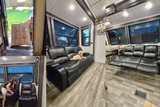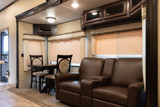How RV Supposed to Drive This Thing??!!
Most of us remember the first time we sat in the driver’s seat of a car. Some may have spent hours in a high school lecture hall watching graphic videos of bad accidents. Some may have endured their parents lecturing on safe driving and the rules of the road, Mom and Dad’s version. It was a little scary. It was a little daunting, but it was also exciting.
The same is true for the first time you get behind the wheel of an RV motorhome or hook a travel trailer to your pickup. Suddenly you’ve gone from driving a normal size vehicle to something that is double or triple the size. The perspectives you’re used to are different now. The tricks you used to center your Buick in the travel lane are no longer useful. You had the right following distance etched into your memory for those commutes but now, just how much distance should you allow? And the clearance under the bridge looks way too low for comfort.
The first time you try anything new there’s bound to be anxiety. Take time to learn the cockpit. Adjust the mirrors, adjust your seat. Figure out where the blind spots are and tweak your mirror alignment or seat position to compensate. Get to know where the wiper controls are, how to turn on the lights, and how to access the turn signals. Commit these to memory so you can turn these on when needed without having to take your eyes off the road to look. This is your wheelhouse; know it.
As the wise ones say, practice makes perfect. Drive the RV as much as you can before it’s time to hit the road.Parking lots during non-peak hours are a good place to drive your RV around, practicing turns, parking, backing, braking and other basic maneuvers. Another option is taking back roads or driving slowly through your subdivision. The more time you spend behind the wheel, the more confidence you’ll have. Smaller roads are also more difficult to maneuver than interstate highways. Spending more time on roads you know will get you ready for the new roadways you’ll find in your travels.
Consider what situations you may find yourself in while traveling. Will fueling up at the gas station be a potential problem for you in your RV? Probably. Experts recommend using truck stop gas stations instead of standard gas stations because truck stops cater to vehicles that need high clearance and more room to maneuver. It is a good idea to have someone stand outside the RV to help you gauge distance from the pump, spot any obstacles in the way, or watch for other potential problems as you pull up to the pump.
There are some other things you should also know. What is the height of your RV? How much does it weigh?These numbers are important to make sure your rig can safely go under overpasses or travel over bridges that have weight restrictions.Even the drive-through at your favorite fast food restaurant may have height restrictions.
The weight also impacts stopping distances. The higher the weight the more time it takes to stop.
Which leads us to a few hints to help with braking safely. Allow enough space to brake safely if something happens ahead of you.On recommendation is to keep a minimum of 400 – 600 feet between your RV and the vehicle ahead of you. You need time to stop, so keep your distance, plan ahead and stay alert.Watch for drivers who will cut in front of you. Adjust your speed to recoup that safe following distance.
Learning other ways to slow the vehicle down is also a good technique and it helps keep your brakes from getting too hot. Downshifting will slow the vehicle down. Watch acceleration going uphill, too, because vehicles that weigh more will pick up speed on the downhill side. This can help you avoid using your brakes more than you have to.
`Another challenge you will face is navigating turns. When you see a semi-tractor trailer making a right-hand turn, you’ll notice that the driver makes a wider turn to compensate for the length of his vehicle. The same is true for anyone towing a trailer.
There’s a phrase for this – tail swing – which is defined as the distance that the body of the vehicle behind the pivot point moves in the opposite direction of the front. Tail swing is not exclusive to RVs, it is also something that any driver of a long vehicle, such as a bus, contends with.If possible, measure the tail swing of your RV by having someone measure the tail swing that occurs as you turn. The average measurement is between 18 and 30 inches. You’ll compensate for this by starting your turn a little farther out into the intersection.
Another tip for the newbie RV driver is to take it slow when you do hit the road for your first adventure. Plan ahead, reserving camping spots ahead of time and planning fuel stops and rest breaks. Stay within the speed limit at a speed at which you are comfortable. Remember that maintaining a steady speed makes fuel consumption more efficient which will feel good for your wallet.
In addition to taking it easy on the road, staying in the right lane is also a courteous to other drivers and is an effective way to learn how to stay in the center of your lane. The right lane gives you the best visibility of the road in front and in back of you. And if there’s a problem, it is easy to move onto the shoulder to fix the problem. You will also have the lane marker on the right-hand side to help you keep your RV out of the other lanes until you become familiar with the width of your rig and how it fits into the travel lane.
Be sure to research weather and road conditions. Inexperience is compounded when faced with wet or icy roads, high winds or other natural occurrences. Construction, detours and other road work hazards can also make travel more stressful than it needs to be. Use computer apps and GPS to find problem areas and take alternative routes.
Learning to drive an RV takes time and effort, but feeling confident behind the wheel will be a welcome reward. It will help you relax and enjoy the journey. Isn’t that what the RV lifestyle is all about?
Lois Tomaszewski is an award-winning journalist and former newspaper editor.
Recent Posts
-
Traveling to the RV Hall of Fame in Elkhart, IN
If you are traveling to Elkhart, IN to see the RV Hall of Fame, getting off the toll road at exit 96 …Nov 14, 2025 -
Best RV Air Conditioners of 2025: An Expert Guide From RecPro
Quick Answers Best overall RV air conditioner: RecPro 15K Quiet AC with Heat Pump (RP-AC3800) Best f …Oct 29, 2025 -
The Nuclear Nomads Expand Sofa with New Recliner Section Install
The Nuclear Nomads are a full time RV family living in south Florida. Andi and Joey value quality ti …Oct 24, 2025 -
Trailer Wiring Guide: How to Wire Your Trailer for Safety and Efficiency
Table of Contents 1. Common Types of Trailer Connectors 2. Trailer Wiring Diagrams: Color Codes and …Aug 20, 2024 -
How to Keep Your Pets Safe While Camping
RVing and camping are a great getaway from the hustle and bustle of work and the city and the day-to …Jul 02, 2024 -
Why Replace Your RV Furniture?
You may wonder when is the best time to replace your RV furniture. There is no one right answer to t …May 20, 2024







